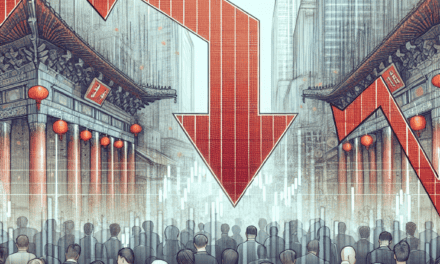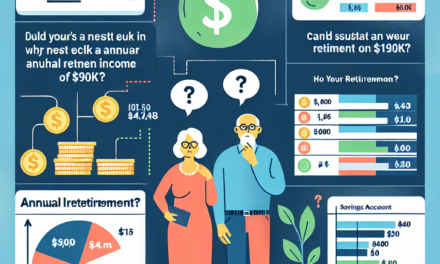“Capri’s Path Forward: Navigating Uncertainty After Tapestry Deal Collapse”
Introduction
Capri Holdings, the parent company of renowned fashion brands such as Michael Kors, Versace, and Jimmy Choo, faces an uncertain future following the collapse of its anticipated acquisition by Tapestry Inc. The deal, which was expected to create a formidable luxury fashion conglomerate, was seen as a strategic move to bolster Capri’s market position and expand its global footprint. However, the abrupt termination of negotiations has left Capri at a crossroads, prompting questions about its strategic direction and financial stability in an increasingly competitive industry. As the company navigates this unexpected turn of events, stakeholders are keenly observing how Capri will adapt its business strategy to maintain its brand prestige and drive growth in a rapidly evolving market landscape.
Impact Of The Failed Tapestry Deal On Capri’s Market Position
The recent collapse of the anticipated acquisition deal between Capri Holdings and Tapestry Inc. has sent ripples through the fashion industry, leaving Capri’s market position in a state of uncertainty. This development has not only raised questions about Capri’s strategic direction but also about its ability to maintain competitiveness in an increasingly challenging market. The failed deal, initially seen as a promising opportunity for Capri to bolster its brand portfolio and expand its global reach, now casts a shadow over its future prospects.
To understand the implications of this failed acquisition, it is essential to consider the context in which Capri operates. The fashion industry is characterized by rapid changes in consumer preferences, intense competition, and the constant need for innovation. In this environment, mergers and acquisitions are often pursued as a means to achieve economies of scale, diversify product offerings, and enhance market presence. For Capri, the deal with Tapestry was expected to provide a strategic advantage by combining resources and expertise, thereby creating a more formidable entity capable of competing with industry giants.
However, with the deal now off the table, Capri faces the challenge of reassessing its market strategy. The company must navigate the complexities of maintaining its brand identity while seeking new avenues for growth. This task is further complicated by the fact that Capri’s competitors are not standing still. Rivals are continuously exploring new markets, investing in digital transformation, and enhancing their sustainability initiatives to attract environmentally conscious consumers. Consequently, Capri must act swiftly to avoid losing ground in this dynamic landscape.
Moreover, the failed deal has financial implications that cannot be overlooked. The anticipation of the merger had likely influenced Capri’s financial planning and resource allocation. With the deal’s collapse, Capri may need to re-evaluate its investment priorities and operational strategies. This could involve redirecting funds towards strengthening its existing brands, such as Michael Kors, Versace, and Jimmy Choo, or exploring partnerships and collaborations that do not involve full-scale mergers. Additionally, Capri must address any potential investor concerns that may arise from the uncertainty surrounding its future direction.
In light of these challenges, Capri’s leadership will play a crucial role in steering the company through this period of uncertainty. Effective communication with stakeholders, including employees, investors, and customers, will be vital in maintaining confidence and trust. Furthermore, Capri’s ability to adapt to changing market conditions and consumer demands will be a key determinant of its success moving forward. This may involve embracing digital innovation, enhancing customer engagement through personalized experiences, and prioritizing sustainability as a core business value.
While the failed Tapestry deal represents a setback for Capri, it also presents an opportunity for introspection and reinvention. By leveraging its existing strengths and exploring new strategic initiatives, Capri can potentially emerge stronger and more resilient. The path forward may not be straightforward, but with careful planning and execution, Capri can navigate the challenges ahead and secure its position in the competitive fashion industry. As the company charts its course, the industry will be watching closely to see how Capri adapts and evolves in response to this pivotal moment.
Strategic Alternatives For Capri Post-Tapestry Deal Collapse
The recent collapse of the anticipated acquisition deal between Capri Holdings and Tapestry Inc. has left Capri at a strategic crossroads, prompting the company to explore alternative paths for its future. This unexpected turn of events has not only disrupted Capri’s immediate plans but also raised questions about its long-term strategy in an increasingly competitive luxury fashion market. As the dust settles, Capri must now reassess its position and consider various strategic alternatives to ensure its continued growth and relevance.
Initially, the proposed merger with Tapestry was seen as a promising opportunity for Capri to expand its market reach and leverage synergies between the two companies. The deal was expected to create a formidable entity in the luxury fashion industry, combining the strengths of Capri’s iconic brands such as Versace, Jimmy Choo, and Michael Kors with Tapestry’s Coach, Kate Spade, and Stuart Weitzman. However, with the deal now off the table, Capri must pivot and explore other avenues to achieve its growth objectives.
One potential strategy for Capri is to focus on strengthening its existing brand portfolio. By investing in brand development and innovation, Capri can enhance the appeal of its products and capture a larger share of the luxury market. This could involve expanding product lines, exploring new collaborations, and leveraging digital platforms to engage with a broader audience. Additionally, Capri could consider enhancing its sustainability initiatives, as consumers increasingly prioritize environmentally conscious brands. By aligning with these values, Capri can differentiate itself and attract a more diverse customer base.
Another strategic alternative for Capri is to pursue strategic partnerships or alliances with other companies in the fashion industry. Collaborations with complementary brands could provide Capri with access to new markets and customer segments, as well as opportunities for shared resources and expertise. Such partnerships could also facilitate innovation and enable Capri to stay ahead of emerging trends. By carefully selecting partners that align with its brand values and vision, Capri can create mutually beneficial relationships that drive growth and enhance its competitive position.
Furthermore, Capri may explore the possibility of expanding its presence in emerging markets. As the global luxury market continues to evolve, regions such as Asia-Pacific and the Middle East present significant growth opportunities. By tailoring its offerings to meet the preferences and demands of these markets, Capri can tap into new revenue streams and diversify its customer base. This expansion could involve opening new retail locations, strengthening e-commerce capabilities, and forming strategic alliances with local partners to navigate cultural nuances and regulatory landscapes.
In addition to these strategies, Capri should also consider optimizing its operational efficiency and cost structure. By streamlining processes and leveraging technology, Capri can improve its supply chain management, reduce costs, and enhance overall profitability. This focus on operational excellence will not only strengthen Capri’s financial position but also provide the flexibility needed to invest in growth initiatives and respond to market dynamics.
In conclusion, the collapse of the Tapestry deal has undoubtedly created uncertainty for Capri Holdings. However, by exploring strategic alternatives such as brand strengthening, strategic partnerships, market expansion, and operational optimization, Capri can navigate this challenging landscape and position itself for future success. As the company charts its path forward, it must remain agile and responsive to industry trends, consumer preferences, and competitive pressures. By doing so, Capri can not only weather the current storm but also emerge as a stronger and more resilient player in the luxury fashion industry.
Investor Reactions To Capri’s Uncertain Future
The recent collapse of the anticipated acquisition deal between Capri Holdings and Tapestry Inc. has left investors grappling with uncertainty regarding Capri’s future. This development has sparked a flurry of reactions from stakeholders, who are now reassessing their positions and strategies in light of the unforeseen turn of events. The deal, which was initially seen as a strategic move to consolidate market presence and leverage synergies between the two fashion giants, was expected to create a formidable entity in the luxury fashion industry. However, with the deal now off the table, investors are left to ponder the implications for Capri’s growth trajectory and market competitiveness.
In the immediate aftermath of the announcement, Capri’s stock experienced notable volatility, reflecting the market’s apprehension about the company’s standalone prospects. Investors, who had anticipated the benefits of a merger, are now recalibrating their expectations. The absence of the anticipated synergies and cost efficiencies that the merger promised has led to a reevaluation of Capri’s financial outlook. Consequently, analysts are revisiting their forecasts, with some expressing concerns about Capri’s ability to maintain its competitive edge in an increasingly challenging market environment.
Moreover, the failed deal has prompted questions about Capri’s strategic direction moving forward. The company, which owns renowned brands such as Michael Kors, Versace, and Jimmy Choo, must now navigate a path that ensures sustainable growth and profitability. Investors are keenly observing how Capri’s management will address these challenges, particularly in terms of innovation, brand positioning, and market expansion. The pressure is on for Capri to demonstrate resilience and adaptability in the face of heightened competition from both established luxury brands and emerging players.
In addition to strategic concerns, the collapse of the deal has also raised issues related to investor confidence. The inability to finalize the merger has led some stakeholders to question the effectiveness of Capri’s leadership and decision-making processes. This skepticism could potentially impact investor sentiment and, by extension, the company’s stock performance in the near term. To mitigate these concerns, Capri’s management will need to engage in transparent communication with investors, outlining a clear and compelling vision for the company’s future.
Furthermore, the broader economic context cannot be ignored. The luxury fashion industry is currently navigating a complex landscape characterized by shifting consumer preferences, digital transformation, and geopolitical uncertainties. In this environment, Capri’s ability to adapt and innovate will be crucial. Investors are particularly interested in how the company plans to leverage technology and data analytics to enhance customer engagement and drive sales. Additionally, sustainability has become a key consideration for consumers and investors alike, and Capri’s commitment to sustainable practices will likely play a significant role in shaping its future success.
In conclusion, the collapse of the Tapestry deal has undeniably cast a shadow of uncertainty over Capri’s future. Investors are now closely monitoring the company’s strategic moves and leadership decisions as they seek reassurance about its ability to thrive independently. While challenges abound, Capri also has the opportunity to redefine its path and capitalize on emerging trends in the luxury fashion industry. Ultimately, the company’s ability to navigate this period of uncertainty will determine its long-term prospects and investor confidence.
Potential Partnerships For Capri After Tapestry Deal Failure

The recent collapse of the anticipated merger between Capri Holdings and Tapestry Inc. has left the fashion industry buzzing with speculation about Capri’s next strategic move. As the dust settles from the failed deal, Capri, the parent company of renowned brands such as Michael Kors, Versace, and Jimmy Choo, finds itself at a crossroads. The potential partnership with Tapestry, which owns Coach, Kate Spade, and Stuart Weitzman, was seen as a promising opportunity to create a formidable luxury fashion conglomerate. However, with the deal now off the table, Capri must explore alternative avenues to secure its future in an increasingly competitive market.
In light of the failed merger, Capri’s leadership is likely to reassess its strategic priorities and explore new partnerships that align with its long-term vision. One potential avenue could be a collaboration with European luxury giants such as LVMH or Kering. These companies have a proven track record of successfully integrating and elevating luxury brands within their portfolios. A partnership with such a powerhouse could provide Capri with the resources and expertise needed to expand its global footprint and enhance its brand equity.
Alternatively, Capri might consider forming alliances with emerging markets, particularly in Asia, where the appetite for luxury goods continues to grow. By partnering with local companies or investors, Capri could tap into these burgeoning markets and establish a stronger presence in regions that are becoming increasingly influential in the fashion industry. This approach would not only diversify Capri’s revenue streams but also mitigate risks associated with over-reliance on Western markets.
Moreover, Capri could explore strategic partnerships with technology companies to enhance its digital capabilities. In an era where e-commerce and digital marketing are paramount, aligning with tech firms could provide Capri with the tools to innovate and adapt to changing consumer behaviors. By leveraging data analytics, artificial intelligence, and virtual reality, Capri could create personalized shopping experiences that resonate with modern consumers, thereby strengthening customer loyalty and driving sales.
In addition to external partnerships, Capri may also focus on internal restructuring to optimize its operations and improve efficiency. This could involve streamlining its supply chain, investing in sustainable practices, and enhancing its direct-to-consumer channels. By prioritizing sustainability, Capri could appeal to environmentally conscious consumers and position itself as a leader in responsible fashion. Furthermore, enhancing its direct-to-consumer strategy would allow Capri to have greater control over its brand narrative and customer interactions, ultimately leading to increased profitability.
While the failure of the Tapestry deal presents challenges, it also offers Capri an opportunity to redefine its strategic direction and explore new possibilities. The fashion industry is dynamic and ever-evolving, and companies that can adapt to changing trends and consumer preferences are more likely to thrive. As Capri navigates this period of uncertainty, it must remain agile and open to innovative solutions that can propel it forward.
In conclusion, Capri’s future may be uncertain following the collapse of the Tapestry deal, but it is not without potential pathways to success. By considering partnerships with established luxury conglomerates, exploring opportunities in emerging markets, leveraging technology, and optimizing internal operations, Capri can position itself for growth and resilience in the face of industry challenges. As the company charts its course, the fashion world will be watching closely to see how Capri capitalizes on these opportunities to secure its place in the global luxury market.
Analyzing Capri’s Financial Health Amidst Deal Uncertainty
The recent collapse of the anticipated acquisition deal between Capri Holdings and Tapestry Inc. has left the fashion industry in a state of speculation and uncertainty. This development has prompted analysts and stakeholders to closely examine Capri’s financial health and strategic direction in the wake of the failed merger. As the dust settles, it becomes imperative to understand the implications of this setback on Capri’s future prospects and its position within the competitive luxury fashion market.
Initially, the proposed merger was seen as a strategic move that would have combined the strengths of both companies, potentially creating a formidable entity in the luxury fashion sector. Tapestry, known for its brands like Coach and Kate Spade, and Capri, the parent company of Michael Kors, Versace, and Jimmy Choo, were expected to leverage their combined resources to enhance market share and operational efficiencies. However, with the deal now off the table, Capri must reassess its standalone strategy and address the challenges that lie ahead.
One of the primary concerns for Capri is its current financial health, which has been under scrutiny even before the merger talks began. The company has faced fluctuating revenues and profit margins, partly due to the volatile nature of the fashion industry and changing consumer preferences. In recent years, Capri has made significant investments in digital transformation and expanding its global footprint, but these efforts have yet to yield consistent financial returns. Consequently, the company must now focus on optimizing its existing operations and finding new avenues for growth to reassure investors and stakeholders.
Moreover, Capri’s brand portfolio presents both opportunities and challenges. While Michael Kors remains a strong player in the accessible luxury segment, Versace and Jimmy Choo cater to more niche markets. This diverse brand mix requires a nuanced approach to marketing and product development, ensuring that each brand maintains its unique identity while contributing to the overall growth of the company. In light of the failed merger, Capri must now double down on its brand strategies, potentially exploring collaborations, limited editions, and innovative marketing campaigns to capture consumer interest and drive sales.
In addition to internal strategies, Capri must also navigate external market conditions that could impact its financial health. The luxury fashion industry is currently experiencing a shift towards sustainability and ethical practices, with consumers increasingly demanding transparency and responsibility from brands. Capri’s ability to adapt to these trends and integrate sustainable practices into its operations will be crucial in maintaining its competitive edge. Furthermore, the global economic landscape, characterized by inflationary pressures and geopolitical uncertainties, poses additional challenges that could affect consumer spending and supply chain dynamics.
As Capri moves forward, effective leadership and strategic decision-making will be paramount in steering the company through this period of uncertainty. The management team must prioritize clear communication with stakeholders, providing transparency about the company’s financial performance and future plans. Additionally, fostering a culture of innovation and agility within the organization will be essential in responding to market changes and seizing new opportunities.
In conclusion, the collapse of the Tapestry deal has undoubtedly placed Capri Holdings at a crossroads, necessitating a thorough evaluation of its financial health and strategic direction. While challenges abound, the company also has the opportunity to redefine its path and strengthen its position in the luxury fashion market. By focusing on operational efficiency, brand differentiation, and adaptability to market trends, Capri can navigate this uncertain landscape and emerge as a resilient and dynamic player in the industry.
The Role Of Leadership In Navigating Capri’s Future
The recent collapse of the anticipated acquisition deal between Capri Holdings and Tapestry Inc. has left Capri’s future shrouded in uncertainty, prompting a closer examination of the role of leadership in steering the company through these turbulent times. As the fashion industry grapples with rapid changes and evolving consumer preferences, the importance of effective leadership cannot be overstated. Capri Holdings, home to iconic brands such as Michael Kors, Versace, and Jimmy Choo, now faces the challenge of redefining its strategic direction without the anticipated support and resources that the merger with Tapestry would have provided.
In the wake of the deal’s failure, Capri’s leadership must reassess its position in the competitive luxury fashion market. The company’s executives are tasked with not only maintaining brand prestige but also ensuring financial stability and growth. This requires a delicate balance between preserving the unique identities of its brands and adapting to market demands. The leadership team must exhibit a keen understanding of global market trends, consumer behavior, and technological advancements to navigate these complexities effectively.
Moreover, the role of leadership extends beyond strategic planning to encompass the cultivation of a resilient organizational culture. In times of uncertainty, employees look to their leaders for guidance and reassurance. Capri’s leadership must foster an environment that encourages innovation, collaboration, and adaptability. By empowering employees and promoting a shared vision, leaders can galvanize the workforce to overcome challenges and seize new opportunities.
Furthermore, communication is a critical component of effective leadership, particularly in times of uncertainty. Transparent and consistent communication with stakeholders, including employees, investors, and customers, is essential to maintain trust and confidence. Capri’s leadership must articulate a clear and compelling narrative that outlines the company’s path forward, addressing concerns and highlighting potential avenues for growth. This narrative should emphasize the company’s commitment to its core values while also demonstrating a willingness to embrace change.
In addition to internal dynamics, Capri’s leadership must also navigate external pressures, such as economic fluctuations and geopolitical tensions. The global nature of the fashion industry means that Capri is susceptible to a wide range of external factors that can impact its operations and profitability. Leaders must be adept at risk management, identifying potential threats, and developing contingency plans to mitigate their impact. This requires a proactive approach, leveraging data and insights to make informed decisions that safeguard the company’s interests.
As Capri charts its course in the post-deal landscape, the role of leadership in driving innovation becomes increasingly important. The fashion industry is characterized by constant evolution, with new trends and technologies emerging at a rapid pace. Capri’s leaders must be forward-thinking, investing in research and development to stay ahead of the curve. This includes exploring sustainable practices, digital transformation, and new business models that align with changing consumer expectations.
In conclusion, the future of Capri Holdings hinges on the ability of its leadership to navigate the complexities of the current business environment. By demonstrating strategic foresight, fostering a resilient organizational culture, and maintaining transparent communication, Capri’s leaders can guide the company through uncertainty and position it for long-term success. As the company adapts to new realities, the role of leadership will be pivotal in shaping Capri’s trajectory and ensuring its continued relevance in the global fashion industry.
Industry Implications Of The Tapestry-Capri Deal Fallout
The recent collapse of the anticipated merger between Tapestry, Inc. and Capri Holdings has sent ripples through the fashion industry, leaving many to ponder the future of Capri and the broader implications for the luxury market. Initially, the deal was poised to create a formidable entity in the fashion world, combining Tapestry’s stronghold with brands like Coach and Kate Spade with Capri’s impressive portfolio, including Michael Kors, Versace, and Jimmy Choo. However, as negotiations faltered and the deal ultimately fell through, stakeholders are left to assess the ramifications of this significant development.
To begin with, the failure of the Tapestry-Capri merger underscores the complexities inherent in large-scale acquisitions within the fashion industry. Mergers of this magnitude often face challenges related to brand integration, cultural alignment, and strategic vision. In this case, it appears that differing priorities and visions for the future may have played a role in the breakdown of negotiations. Consequently, Capri Holdings now faces the daunting task of navigating its path forward independently, without the anticipated synergies and resources that a merger with Tapestry might have provided.
Moreover, the fallout from this deal has broader implications for the luxury fashion sector, which has been grappling with shifting consumer preferences and economic uncertainties. The merger was seen by many as a strategic move to consolidate resources and strengthen market positioning in an increasingly competitive landscape. With the deal off the table, both companies must now reassess their strategies to remain competitive. For Capri, this means finding ways to leverage its existing brand portfolio to drive growth and innovation, while also addressing any operational inefficiencies that may have been overlooked in anticipation of the merger.
In addition, the collapse of the Tapestry-Capri deal highlights the importance of agility and adaptability in the fashion industry. As consumer behavior continues to evolve, driven by factors such as digital transformation and sustainability concerns, companies must be prepared to pivot quickly and effectively. For Capri, this may involve exploring new markets, investing in digital capabilities, or enhancing its sustainability initiatives to align with consumer expectations. The ability to adapt to these changes will be crucial for Capri as it seeks to maintain its relevance and appeal in a rapidly changing market.
Furthermore, the implications of this failed merger extend beyond Capri and Tapestry, serving as a cautionary tale for other companies considering similar strategic moves. The fashion industry is no stranger to consolidation, with numerous mergers and acquisitions taking place over the years. However, the challenges faced by Tapestry and Capri serve as a reminder of the importance of thorough due diligence, clear communication, and alignment of strategic goals when pursuing such endeavors. Companies must carefully weigh the potential benefits against the risks and complexities involved to ensure successful outcomes.
In conclusion, the collapse of the Tapestry-Capri deal has left Capri Holdings at a crossroads, with significant implications for its future and the broader luxury fashion industry. As Capri navigates this uncertain landscape, it must focus on leveraging its strengths, adapting to changing consumer demands, and exploring new opportunities for growth. Meanwhile, the industry as a whole must take heed of the lessons learned from this failed merger, recognizing the importance of strategic alignment and adaptability in an ever-evolving market.
Q&A
1. **What was the Tapestry deal involving Capri?**
The Tapestry deal was a proposed acquisition where Tapestry Inc. aimed to purchase Capri Holdings, the parent company of brands like Michael Kors, Versace, and Jimmy Choo.
2. **Why did the Tapestry deal fall through?**
The deal fell through due to disagreements over valuation, strategic direction, or regulatory hurdles, although specific reasons were not publicly detailed.
3. **What are the immediate financial implications for Capri?**
Capri may face a decline in stock prices and investor confidence, impacting its market valuation and financial stability.
4. **How might Capri’s brand strategy change post-deal?**
Capri might focus on strengthening its core brands, exploring new markets, or restructuring to improve profitability and competitiveness.
5. **What are potential challenges Capri faces now?**
Capri faces challenges such as maintaining brand relevance, managing operational costs, and competing with larger fashion conglomerates.
6. **Are there any potential suitors for Capri after the failed deal?**
Other fashion or luxury goods companies might express interest, but no specific suitors have been publicly identified.
7. **What is the outlook for Capri’s future in the fashion industry?**
Capri’s future is uncertain, with potential for recovery through strategic initiatives or partnerships, but it also risks further financial and market challenges.
Conclusion
The collapse of the Tapestry deal leaves Capri Holdings in a precarious position, facing an uncertain future. Without the anticipated merger, Capri must navigate the competitive luxury fashion market independently, potentially missing out on synergies and expanded market reach that the deal promised. The company may need to reassess its strategic direction, focusing on strengthening its brand portfolio, enhancing operational efficiencies, and exploring alternative partnerships or acquisitions to maintain growth and shareholder value. Additionally, Capri must address any investor concerns and market skepticism resulting from the failed deal to stabilize its financial standing and market perception.





